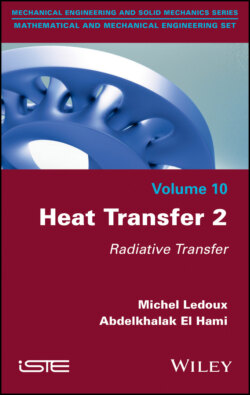Heat Transfer 2

Реклама. ООО «ЛитРес», ИНН: 7719571260.
Оглавление
Abdelkhalak El Hami. Heat Transfer 2
Table of Contents
List of Tables
List of Illustrations
Guide
Pages
Heat Transfer 2. Radiative Transfer
Preface
Introduction. I.1. Preamble
I.2. Introduction
I.3. Interlude
1. General Remarks. 1.1. Introduction
1.2. Propagation of a sinusoidal electromagnetic wave. 1.2.1. Frequencies and wavelengths
1.2.2. Radiation spectrum
1.3. The concept of photometry. 1.3.1. Geometric parameters
1.3.2. Radiance
1.3.3. Bouguer–Lambert law
1.3.4. Intensity
1.3.5. Lambert’s law – a surface’s emissivity. 1.3.5.1. Lambert’s law
1.3.5.2. A surface’s emissivity
1.3.5.3. Intensity indicator of a Lambertian source
2. Calculating Luminances. 2.1. Introduction
2.2. The black body: concept, luminance, Planck’s law and approximations. 2.2.1. Paradoxically, the black body is defined with reference to its absorption
2.2.2. Black body luminance
2.2.3. Emittance from the black body
2.2.4. Approximations of the luminance of the black body
2.2.5. Writing the luminance in terms of frequency
2.3. Stefan–Boltzmann law. 2.3.1. Establishing the law
2.3.2. A direct application
2.4. Wien’s laws
2.4.1. Wien’s displacement law
2.4.2. Wien’s second law
2.4.3. Greenhouse effect
2.5. Fraction of the total emittance of a black body radiated in a spectral band. 2.5.1. An important tool:G0−λTfunctions
2.5.2. An application
2.6. Emissivity of any body: a general case of a non-black body. 2.6.1. Definition of monochromatic emissivity
2.6.2. Definition of global emissivity: a tricky concept
2.6.3. Emissivity of a gray body: a particular case
2.7. Simple applications
3. Emission and Absorption. 3.1. Introduction
3.2. Absorption, reflection, transmission
3.3. Kirchhoff’s law
3.4. Recap on the global absorption coefficient. 3.4.1. General case
3.4.2. Case of the gray body
3.5. General case: multiple transfers
3.6. Absorption: the Beer–Lambert law. 3.6.1. Radiation transfer
3.6.2. Beer’s law
4. Radiation Exchanges Between Surfaces. 4.1. Introduction
4.2. Classification
4.3. The case of total influence
4.3.1. The case of two parallel plates. Lambert’s law
4.3.2. Total influence between two black body surfaces, of temperaturesTWandTa
4.3.3. Total influence between two surfaces
4.3.4. Total influence between two surfaces
4.3.5. Wall in total influence in an enclosure
4.3.6. Important note on the “thermal balance”
4.3.7. A practical approximation
4.3.7.1. Approximations
4.3.7.2. Orders of size
4.3.7.3. Demonstration
4.3.8. Complex system of radiant finished surfaces: geometric form factor
4.3.9. Application
5. Analytic Applications. 5.1. Introduction
5.2. Radiators, convectors and radiating fins
5.3. Radiation and oven
5.4. Radiation and metrology
5.4.1. Measuring a thermal conductibility
5.5. General problems
6. Modeling and Simulations under ANSYS. 6.1. Conduction, convection and radiation
6.2. Conduction and convection using ANSYS software
6.2.1. Representation of the temperature field
6.3. Radiation using ANSYS software
6.4. Examples of modeling and analysis with ANSYS
6.4.1. Simple thermal conduction
6.4.2. Mixing conduction/convection/isolation
6.4.3. Transient thermal conduction
6.4.4. Study of thermal transfers from a brick wall and a cement wall (application to an oven)
6.4.5. Study of stationary thermal conduction in a reservoir intersected by a tube
6.4.6. Stationary thermal conduction on a cylinder
6.4.7. Cooling of a puck in transitory thermal
6.4.8. Study of a heat exchanger
6.5. Study of a thermal exchanger on ANSYS. 6.5.1. Effectiveness of the PCM
6.5.2. Parameterizing the analysis
6.5.4. Thermal exchanger with hydrated salt
6.5.5. Thermal exchanger with paraffin
6.5.6. Influence of heat flux
6.5.7. Comparing PCM
6.6. Conclusion
Appendix. G0−λT Function Table
References
Index. A, B, C
E, F, G
I, L, O, P
R, S, T, W
WILEY END USER LICENSE AGREEMENT
Отрывок из книги
Mathematical and Mechanical Engineering Set
.....
Let us entrust Ludwig Boltzmann to direct the film. Our B movie heroes are getting agitated, delivering blows to one another. Each one of them has moderate kinetic energy, distributed heterogeneously among them in the room. For some reason, they get involved in a general brawl. Their average kinetic energy becomes much greater.
In everyday language, we would say that things are hotting up.
.....